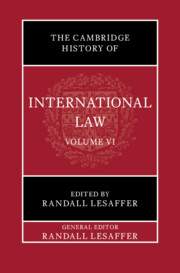Book contents
- The Cambridge History of International Law
- The Cambridge History of International Law
- Frontispiece
- The Cambridge History of International Law
- Copyright page
- Contents
- Plates
- Contributors
- Preface
- Abbreviations
- Part I International Law in Renaissance Europe (1492–1660)
- 1 The Law of Nations in Renaissance Europe
- 2 Territory and Jurisdiction in Renaissance Europe
- 3 Beyond the Free Sea
- 4 War and the Use of Force in Renaissance Europe
- 5 Warfare on Land in Renaissance Europe
- 6 The Law of Maritime Warfare during the Transition between Medieval and Early Modern Europe
- 7 Peacemaking in Renaissance Europe
- 8 Trade and Navigation in Renaissance Europe
- 9 Diplomacy in Renaissance Europe
- 10 Dispute Settlement in Renaissance Europe
- 11 The Ottoman Encounter and the Law of Nations in the Renaissance
- Part II International Law in Old Regime Europe (1660–1775)
- Index
- Plate Section (PDF Only)
- References
10 - Dispute Settlement in Renaissance Europe
from Part I - International Law in Renaissance Europe (1492–1660)
Published online by Cambridge University Press: 22 April 2025
- The Cambridge History of International Law
- The Cambridge History of International Law
- Frontispiece
- The Cambridge History of International Law
- Copyright page
- Contents
- Plates
- Contributors
- Preface
- Abbreviations
- Part I International Law in Renaissance Europe (1492–1660)
- 1 The Law of Nations in Renaissance Europe
- 2 Territory and Jurisdiction in Renaissance Europe
- 3 Beyond the Free Sea
- 4 War and the Use of Force in Renaissance Europe
- 5 Warfare on Land in Renaissance Europe
- 6 The Law of Maritime Warfare during the Transition between Medieval and Early Modern Europe
- 7 Peacemaking in Renaissance Europe
- 8 Trade and Navigation in Renaissance Europe
- 9 Diplomacy in Renaissance Europe
- 10 Dispute Settlement in Renaissance Europe
- 11 The Ottoman Encounter and the Law of Nations in the Renaissance
- Part II International Law in Old Regime Europe (1660–1775)
- Index
- Plate Section (PDF Only)
- References
Summary
In the early modern age, the settlement of disputes between the actors of ‘international’ relations hinged on communication channels and negotiation networks that were meant to limit the recourse to violence. Multireligious Renaissance Europe saw the emergence of the jus gentium – as a distinct, gestating branch of law – and modern diplomacy, perceived as a social and cultural practice used not only by sovereigns, but also by non-sovereign actors – a practice allowing both Europeans and non-Europeans to engage in formal and informal interactions, in state and non-state settings, through the elaboration of common languages, of (verbal and symbolic) communication practices and of shared political and legal cultures. In a belligerent era, which spawned many wars, European diplomacy developed new forms of negotiation that attest to an elaborate ‘art of peace’. By the end of the period, the Thirty Years War ended with the first experience of dispute settlement through multilateral talks involving nearly all European powers in Westphalia (1643-9) and reflecting conflicts that attest to the successive integration of non-European territories in ongoing European dispute. The congress demonstrated both the effectiveness and the limitations of this innovative negotiation model.
- Type
- Chapter
- Information
- The Cambridge History of International Law , pp. 329 - 356Publisher: Cambridge University PressPrint publication year: 2025

